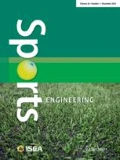Abstract
This paper describes the optimal flight of a discus. Two objective functions are considered. One is the flight distance, and the other is robustness. Robustness is defined as insensitivity to deviations from the local optimal release conditions. The aim of the optimization is to maximize both flight distance and robustness. There are ten control and design variables, which include variables concerned with the skill of the thrower and with the design of the equipment. It was found that there is a trade-off between flight distance and robustness. It was also found that lower drag is preferable in the first half of flight, and greater lift and drag are preferable in the latter half of flight for the world record throw of 77 m. In order to do this, the initial angle between the velocity vector and the discus planform should be negative at the launch, even if the initial lift acts vertically downward. The attitude of the discus should be inclined at launch. The discus rolls with time during the flight, so that the discus planform becomes almost in the horizontal plane in the latter half of the flight. Lower mass is good for achieving longer flight distance, but conversely, mass should be slightly greater for robustness.












Similar content being viewed by others
References
Hubbard M, Cheng K (2007) Optimal discus trajectories. J Biomech 40:3650–3659
Kentzer CP, Hromas LA (1958) Discobolus 4, 1. (Available in 2001 from Barry Willis, 14 Bluebridge Avenue, Brookmans Park, Hatfield, Herts, UK.)
Ganslen RV (1964) Aerodynamic and mechanical forces in discus flight. Athl J 44:50
Soong T-C (1976) The dynamics of discus throw. J Appl Mech 98:531–536
Seo K, Shimoyama K, Ohta K, Ohgi Y, Kimura Y (2012) Aerodynamic behavior of a discus. Procedia Eng 34:92–97
Anderson John D (2001) Fundamentals of aerodynamics, 3rd edn. McGraw Hill, New York
Stevens B, Lewis F (2003) Aircraft control and simulation, 2nd edn. Wiley, Hoboken
Seo K, Shimoyama K, Ohta K, Ohgi Y, Kimura Y (2012) Optimization of the moment of inertia and the release conditions of a discus. Proc Eng 34:170–175
Seo K, Kobayashi O, Murakami M, Yorita D, Nagai H, Asai K (2010) Simulation of the trajectory of a punted rugby ball taking into account the asymmetrical pressure distribution caused by the seams. J Vis 13:97–105
Sasaki D, Obayashi S (2005) Efficient search for trade-offs by adaptive range multi-objective genetic algorithms. AIAA J Aerosp Comput Inf Commun 2:44–64
Shimoyama K, Seo K, Nishiwaki T, Jeong S, Obayashi S (2011) Design optimization of a sport shoe sole structure by evolutionary computation and FEM analysis. J Sports Eng Technol 225(4):179–188
Leigh S, Liu H, Hubbard M, Yu B (2010) Individualized optimal release angles in discus throwing. J Biomech 43:540–545
Metropolis N, Ulam S (1949) The monte carlo method. J Am Stat Assoc 44:335–341
Kohonen T (1995) Self-organizing maps. Springer, Berlin
Obayashi S, Jeong S, Shimoyama K, Chiba K, Morino H (2010) Multi-objective design exploration and its applications. J Aeronaut Space Sci 11:247–265
Acknowledgements
I would like to thank Professor Emeritus Masahide Murakami, University of Tsukuba, for fruitful discussions and suggestions. This work is supported by a Grant-in-Aid for Scientific Research (A), Japan Society for the Promotion of Science.
Author information
Authors and Affiliations
Corresponding author
Rights and permissions
About this article
Cite this article
Seo, K., Shimoyama, K., Ohta, K. et al. Optimization of flight distance and robustness in the discus. Sports Eng 18, 55–65 (2015). https://doi.org/10.1007/s12283-014-0166-y
Published:
Issue Date:
DOI: https://doi.org/10.1007/s12283-014-0166-y




